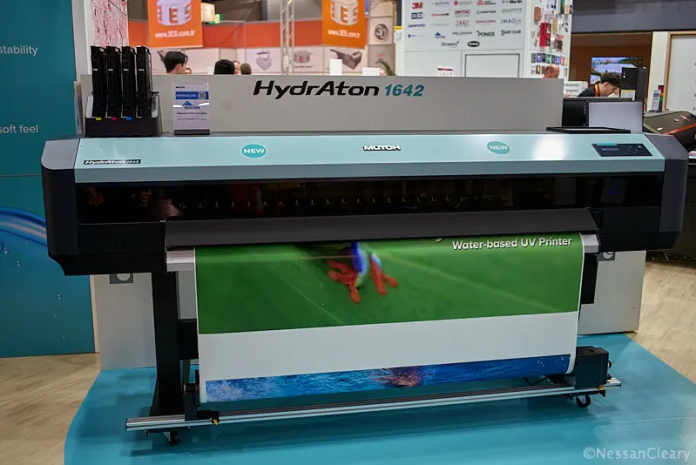
Fujifilm has developed a new AquaFuze hybrid ink technology for the wide format market. To complement this, Mutoh has built a 1.6m wide rollfed printer, which Mutoh calls HydrAton 1642 and which Fujifilm will sell as the Acuity Triton, both of which were demonstrated at the drupa show.
The AquaFuze ink uses water as its carrier, which makes up 70% of the mix, plus the pigments and UV-curable latex elements. The basis behind the AquaFuze ink is the emulsion dispersion technology that Fujifilm originally developed for the photo industry, ensuring that all the elements remain in suspension relative to each other. Keita Yamamuro, senior group manager for digital printing at Fujifilm Business Innovation, says, “We keep the photopolymer dispersion in the water and it’s very stable.”
The printer is fitted with both a UV LED array and a heater with an air knife to direct the heat. This heat causes the latex to melt, which forms a membrane and holds the pigment to the substrate while the LED lamp then reacts with the UV elements, causing that membrane to solidify and bond with the substrate. There’s no need for any primer or optimizer and the inks will work with most common wide-format materials.
As with other UV-curable inks, the prints are immediately dry upon exposure to UV light. In addition, the heater helps to evaporate away the water. This process aids the overall robustness of the prints, which are said to be rub- and scratch-resistant, so there’s no need for additional overcoating.
The heater temperature is less than 50°C so the system should be more suitable for heat-sensitive materials than with latex/ resin or solvent printers. Stephan Heintjens, general manager of applications and marketing for Mutoh Europe adds, “Most of what we print is at 30-40°C.”
Hybrid inks generally involve a trade-off between the extra functionality gained from combining different technologies against the extra complexity involved. In this case, that complexity is mainly down to the printer, which requires both heating and UV curing, pushing up its cost.
But Fujifilm is no stranger to this, having previously developed a hybrid Fuze ink for its Vybrant F1600 printer, which combined UV elements with a solvent carrier. The goal then was to come to market with an ink that would be cheaper than a standard UV-curable ink by eliminating the need for expensive photo-initiators. The AquaFuze ink builds on this, using the UV elements to cut down on the energy normally required for drying water-based inks. So essentially, the AquaFuze ink is targeting the same entry-level market, with a straightforward four-color CMYK inkset, but with a more environmentally friendly approach.
Heintjens expects it to achieve the same non-hazardous level of certification as Mutoh’s current MS51 eco-solvent ink, adding, “There’s a lot of legislation for interior work.” The ink is said to emit very low VOC and to have low odor. There’s no need for a GHS label.
He continues, “We want to keep the applications we have intact but come with a technology that’s more defensible in the current market, for environmental and health and safety. So this is what the AquaFuze will do for us.”
Nick Decock, marketing manager for Mutoh Europe, says that the main advantage of this system is its very low energy consumption as opposed to a solvent printer. Of course, you could make the same argument for any printer using LED UV curing but in this case, the printer and the ink should also be much cheaper than an equivalent UV model. Heintjens suggests that Mutoh sees AquaFuze primarily as an alternative to latex/ resin ink systems.
The ink cures to a very thin film, which means that it’s not suitable for producing textured effects, but does allow the look and feel of the underlying substrate to come through. The main target markets are sign and display, plus wallpaper and interior decoration, with Mutoh showing some very nice samples that have benefited from the thin film. Decock adds, “We are still discovering what the main markets would be.”
Interestingly, Yamamuro says that Fujifilm will offer the ink to other printer manufacturers once the concept is established. This may appeal to some vendors that lack their IP around latex or resin inks and are looking for a cheaper alternative to those, and as ever-tightening regulation makes solvent inks less desirable.
Mutoh’s HydrAton should be available in Q4 this year and cost roughly 23,000 Euros, with Fujifilm’s Acuity Triton also appearing around the same time. You can find further details on both companies from fujifilm.com and mutoh.eu.
















